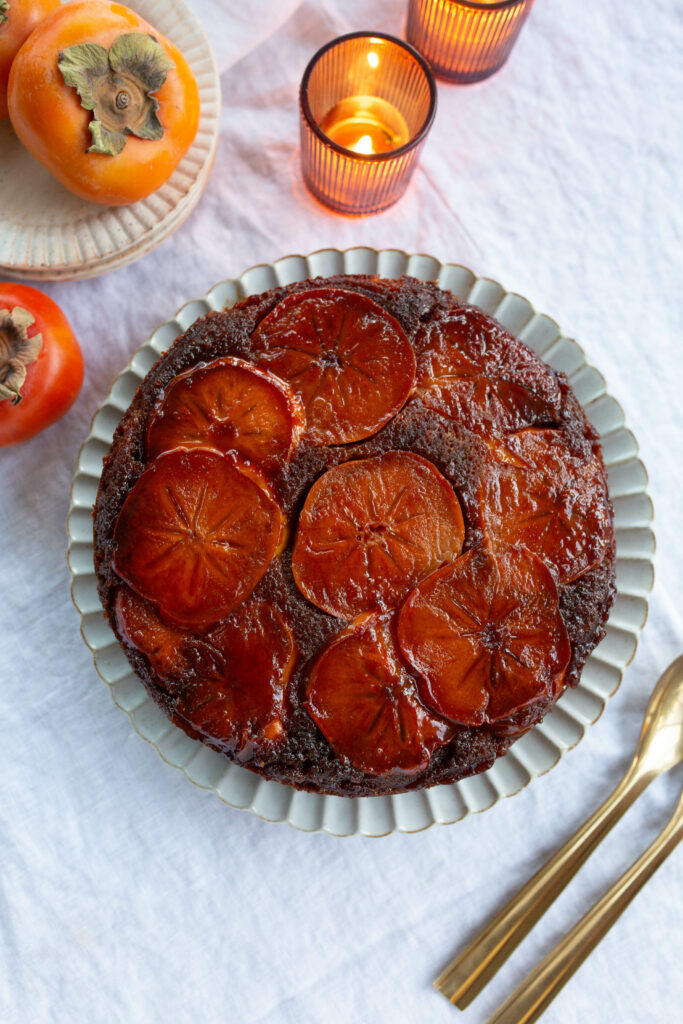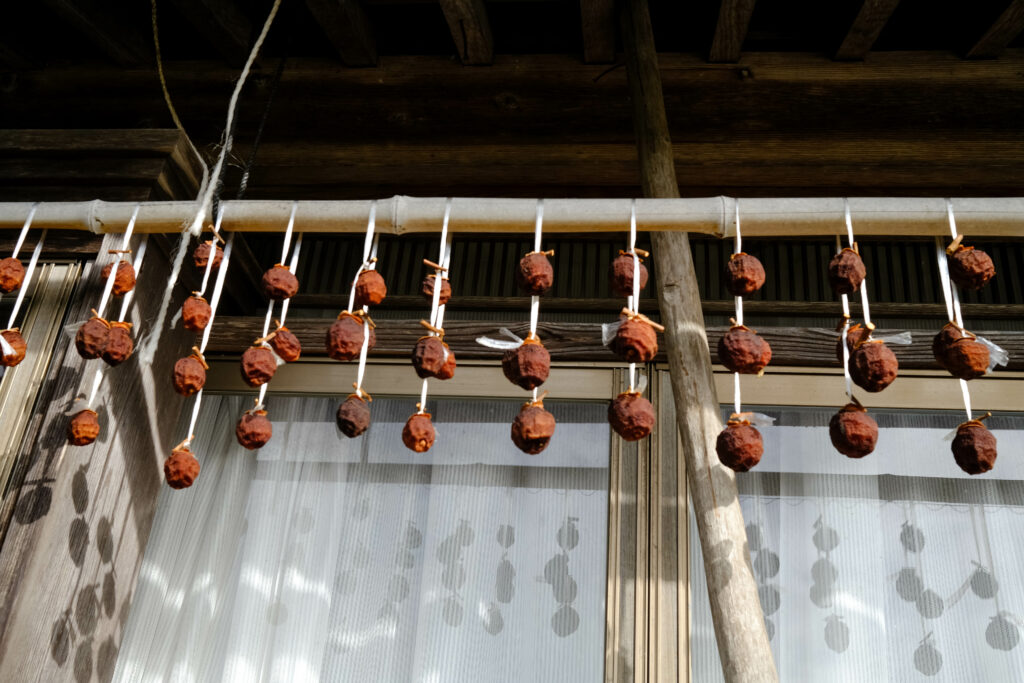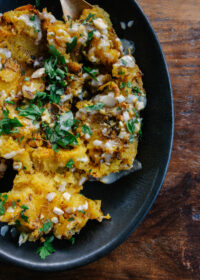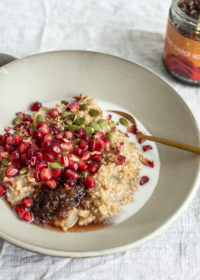Recipe: Persimmon Upside Down Cake
 The past month has been a wonderful whirlwind in my home life. I got married at the end of October and left for Japan shortly after. We planned our honeymoon to be a mix of our interests: food, markets, tea culture and tea farming, traditional agricultural practices, and garden design. He’s a landscape architect, I’m a cook. We meet in the middle around the kitchen table and tea table to share our love for food, agriculture and design.
The past month has been a wonderful whirlwind in my home life. I got married at the end of October and left for Japan shortly after. We planned our honeymoon to be a mix of our interests: food, markets, tea culture and tea farming, traditional agricultural practices, and garden design. He’s a landscape architect, I’m a cook. We meet in the middle around the kitchen table and tea table to share our love for food, agriculture and design.
We traveled by plane, rail and car from Tokyo to Kyoto, exploring the cities and wandering the countryside between the two. This trip has sparked my curiosity in Japanese cooking, so you’ll likely see more recipe posts around this theme in the months ahead. But for this week, we arrived home on the cusp of Thanksgiving and I couldn’t miss my annual blog tradition of sharing recipes to inspire your winter feasting. Now that it’s finally cooled down here in Hawaii, I can comfortably crank up my oven and embark on all the holiday roasting, braising and baking. This is my favorite time of year in the kitchen. Fall was in full swing in Japan when we arrived, with all the maples and gingko parading their colorful changing leaves. Every home seemed to have a persimmon tree, leafless but dotted with ripe, bright orange fruit. The persimmon tree (Diospyros kaki) has a long and rich history in Japan. The persimmon represents the arrival of Autumn and is a symbol of prosperity. There is even a tradition of giving persimmons as gifts during the fall to celebrate the harvest and express good wishes. Not only in homes, you’ll often persimmon trees woven into the landscape architecture, particularly around tea gardens, where the design is influenced by the principles of simplicity and natural beauty found in the expression of the seasons. The changing colors of the persimmon tree is considered to enhance the contemplative atmosphere of these spaces.
Fall was in full swing in Japan when we arrived, with all the maples and gingko parading their colorful changing leaves. Every home seemed to have a persimmon tree, leafless but dotted with ripe, bright orange fruit. The persimmon tree (Diospyros kaki) has a long and rich history in Japan. The persimmon represents the arrival of Autumn and is a symbol of prosperity. There is even a tradition of giving persimmons as gifts during the fall to celebrate the harvest and express good wishes. Not only in homes, you’ll often persimmon trees woven into the landscape architecture, particularly around tea gardens, where the design is influenced by the principles of simplicity and natural beauty found in the expression of the seasons. The changing colors of the persimmon tree is considered to enhance the contemplative atmosphere of these spaces.
 When you drive through the countryside, you’ll see the windowsills of homes covered in rows of hanging persimmons to make “hoshigaki” – dried persimmons. Hoshigaki are whole persimmons that are peeled, dried, and massaged to create a sweet and chewy delicacy. The dried persimmons are enjoyed as a snack during the colder months and are also used in traditional New Year’s celebrations. The hoshigaki-making process involves peeling the persimmons, hanging them to dry, and then massaging or gently kneading them periodically as they dry. This labor-intensive process can take several weeks, during which the persimmons gradually transform into sweet, moist, and chewy delicacies. We were gifted a few while we were in the Noto Peninsula, and I swiftly fell back in love with this fruit that I had forgotten about.
When you drive through the countryside, you’ll see the windowsills of homes covered in rows of hanging persimmons to make “hoshigaki” – dried persimmons. Hoshigaki are whole persimmons that are peeled, dried, and massaged to create a sweet and chewy delicacy. The dried persimmons are enjoyed as a snack during the colder months and are also used in traditional New Year’s celebrations. The hoshigaki-making process involves peeling the persimmons, hanging them to dry, and then massaging or gently kneading them periodically as they dry. This labor-intensive process can take several weeks, during which the persimmons gradually transform into sweet, moist, and chewy delicacies. We were gifted a few while we were in the Noto Peninsula, and I swiftly fell back in love with this fruit that I had forgotten about. There are two main types of persimmons: astringent and non-astringent. The distinction between these types is based on the presence of tannins, compounds that give astringent persimmons a puckering or dry sensation when eaten before they are fully ripe. If you find this interesting like I do, then here’s a bit more on the types of persimmon you will commonly eat and cook with:
There are two main types of persimmons: astringent and non-astringent. The distinction between these types is based on the presence of tannins, compounds that give astringent persimmons a puckering or dry sensation when eaten before they are fully ripe. If you find this interesting like I do, then here’s a bit more on the types of persimmon you will commonly eat and cook with:
- Astringent Persimmons:
- Hachiya: Hachiya persimmons are one of the most well-known astringent varieties. They are large, acorn-shaped fruits with a smooth and shiny skin. When unripe, Hachiya persimmons are extremely astringent, but as they ripen and soften, they become sweet and custard-like in texture. They are often used in baking, cooking, and for making hoshigaki (dried persimmons).
- Gosho/Giant Fuyu: This is another variety of astringent persimmon. It is similar in shape to the Hachiya but larger. It has a pointed base and is typically elongated. Like Hachiya, it needs to be fully ripe to be enjoyed.
- Amagaki: This is a smaller, round, and flattened variety of astringent persimmon. It is known for its sweet and spicy flavor when fully ripe.
- Non-Astringent Persimmons:
- Fuyu: Fuyu persimmons are the most common non-astringent variety. They are squat and round, resembling a slightly flattened tomato. Fuyu persimmons are crisp and can be eaten while still firm. They have a sweet, mild flavor and are often enjoyed fresh as a snack or in salads. These are the kind I’m working with in the cake recipe below.
- Jiro: Similar to Fuyu, Jiro persimmons are non-astringent and can be eaten while still firm. They have a sweet and mild flavor.
When making this spiced persimmon upside down cake, you’ll want to select a non-astringent persimmon. The smaller fuyu persimmons that are still firm are the best for this recipe. Slice them horizontally and layer them across the bottom of the springform pan to get the visuals of these vibrant fruits. If they’re too soft to slice, try making a jam or this raw vegan cake recipe as an alternative. As we plan our last minute Thanksgiving menu this year, I’ll be serving this cake alongside a kabocha & pumpkin pie at our dessert table. Here’s a peek at the rest of our holiday menu:
As we plan our last minute Thanksgiving menu this year, I’ll be serving this cake alongside a kabocha & pumpkin pie at our dessert table. Here’s a peek at the rest of our holiday menu:
Our Thanksgiving Menu
Herbal Spiced Apple Cider
Coriander Carrot Soup with Carrot Top Chutney
Roasted Sweet Potato & Radicchio Salad
Blistered Green Beans with Preserved Lemon
Celeriac Parsnip Mash
Sourdough Stuffing
Ghee Roasted Chicken
Kabocha Squash Pie
Spiced Persimmon Upside Down Cake (recipe below)
If you’re looking for more recipe ideas, explore a decade of Thanksgiving Guides on the blog: 2013, 2014, 2015, 2016, 2017, 2018, 2019, 2020, 2021 & 2022. Whether you’re going full veggie this year, or peppering in a few side dishes and desserts, you’ll find dozens of plant-forward sweet and savory recipes to enjoy.
SPICED PERSIMMON UPSIDE DOWN CAKE
Persimmon Topping:
3-4 ripe Fuyu persimmons, peeled and sliced into ¼” thick rounds
¼ cup ghee
½ cup maple syrup
2 tbsp fresh orange juice
1 tsp vanilla extract
First, grease a 9-inch round cake pan and line the bottom with parchment paper. Prepare the persimmon topping. In a small saucepan, melt 1/4 cup of ghee over medium heat. Add maple syrup, orange juice and vanilla extract. Simmer on a medium-low heat to reduce the mixture until it’s thick and caramel-like, stirring occasionally so it does not burn. Pour the mixture into the prepared cake pan, cover the bottom evenly. Arrange the sliced persimmons on top of the caramel in a circular pattern. Set aside.
Cake Batter:
1 ½ cups spelt flour (or gluten-free all-purpose flour)
½ cup almond flour
2 tsp ground cinnamon
¼ tsp ground ginger
⅛ tsp ground clove
1 tsp baking powder
½ teaspoon baking soda
¼ teaspoon Himalayan pink salt
½ cup ghee, softened
1 ¼ cup coconut sugar (or organic brown sugar)
2 large organic eggs (or 2 flax eggs – 2 tbsp ground flax whisked with 6 tbsp water)
1 tbsp vanilla extract
1 tbsp orange zest
1 cup organic unsweetened dairy-free milk
Preheat your oven to 350°F (175°C). Prepare the cake batter. In a medium bowl, whisk together the spelt or gluten-free flour, the almond flour, baking powder, baking soda, spices and salt. In a separate mixing bowl, cream together the softened ghee and sugar until light and fluffy. Add the eggs one at a time, beating well after each addition. Gradually fold in the dry mixture into the wet mixture. At the end, whisk in the milk, vanilla and orange zest until the batter is smooth.
Carefully pour the batter over the arranged persimmons in the cake pan, spreading it evenly. Line a baking sheet with parchment and place the cake pan on top of the lined baking sheet (this will catch any gooey caramel that leaks out of the bottom of the cake pan while baking!). Place in the oven for 45-50 minutes or until a toothpick inserted into the center of the cake comes out clean.
Allow the cake to cool in the pan for about 15 minutes. Run a knife around the edges to loosen the cake. Place a serving plate upside down on top of the cake pan and carefully invert the cake onto the plate. Let the cake cool completely before slicing. Serve with your favorite mug of tea.
Yield: 8 slices (one 9-inch cake)
 [wpmenucart]
[wpmenucart] Recipe: Whole Roasted Acorn Squash
Recipe: Whole Roasted Acorn Squash  Recipe: Carrot Coriander Soup
Recipe: Carrot Coriander Soup  Recipes: Pomegranate, Pear & Rose Breakfast Porridge
Recipes: Pomegranate, Pear & Rose Breakfast Porridge 
I want to come to your Thanksgiving!
Come on over, friend!
The ingredients do not list buttermilk; however, the instructions do. Can you clarify?
Hi Katie! Thanks for catching this typo, I’ve updated the instructions in the recipe post.
In a medium bowl, whisk together the spelt or gluten-free flour, the almond flour, baking powder, baking soda, spices and salt. In a separate mixing bowl, cream together the softened ghee and sugar until light and fluffy. Add the eggs one at a time, beating well after each addition. Gradually fold in the dry mixture into the wet mixture. At the end, whisk in the milk, vanilla and orange zest until the batter is smooth.
I hope it turned out for you in the end!